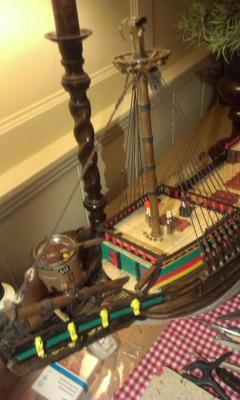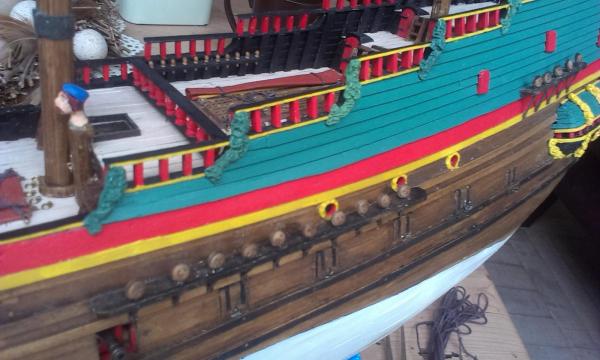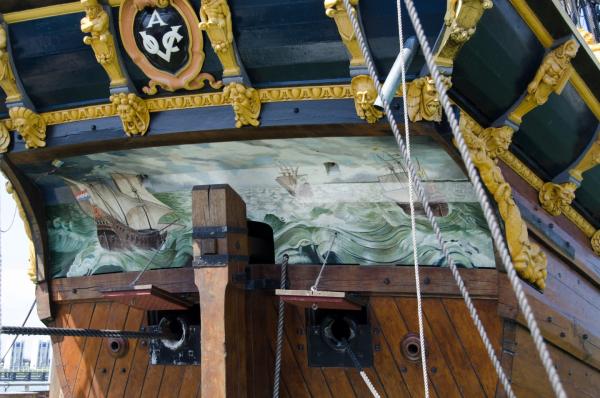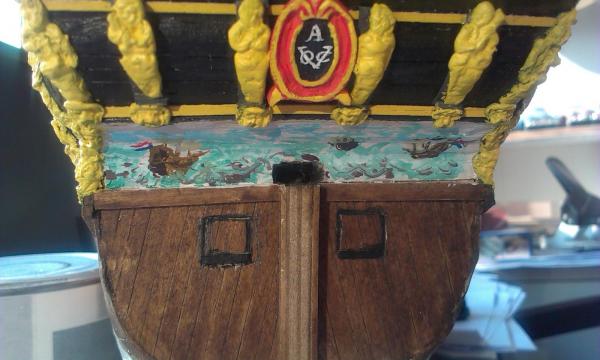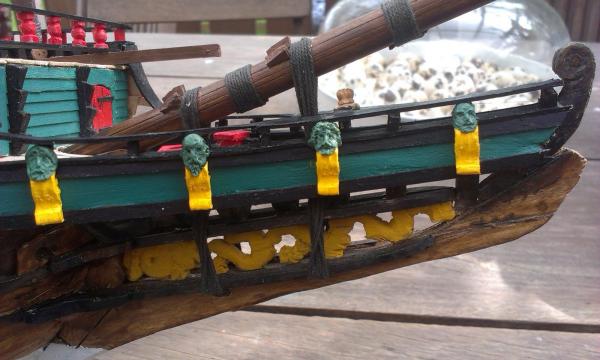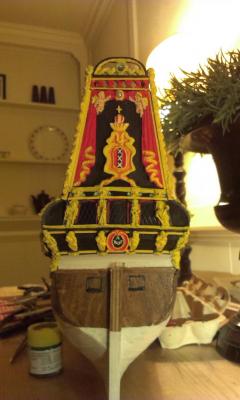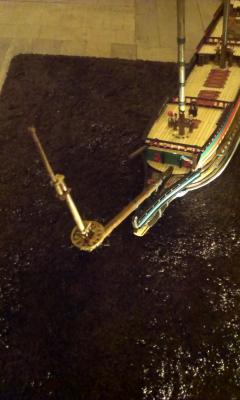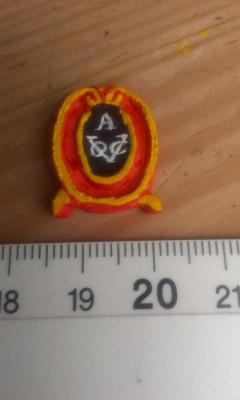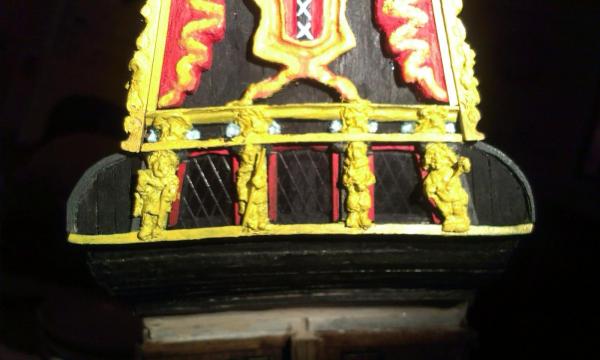-
Posts
450 -
Joined
-
Last visited
Content Type
Profiles
Forums
Gallery
Events
Everything posted by *Hans*
-
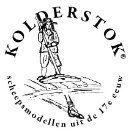
Batavia by *Hans* - FINISHED
*Hans* replied to *Hans*'s topic in - Build logs for subjects built 1501 - 1750
Last weeks I have been busy on the foremast and the mainmast - started with the standing rigging of both. For the foremast this was no trouble, but starting with the rigging of the mainmast I realised I first had to make the mermen on the rail on both sides. Standing rigging on the foremast Mermen on the rail -
Like Grandma in Downton Abbey Then I can imagine she is familiar with Marktplaats and would be able to buy such an item for you (if you want to have it though - because scratch-builing can be nicer than out of a box building).
- 85 replies
-
- yacht mary
- mamoli
-
(and 1 more)
Tagged with:
-

Batavia by *Hans* - FINISHED
*Hans* replied to *Hans*'s topic in - Build logs for subjects built 1501 - 1750
Yeah. Either 2 or 20 million - I both don't have it... -
Correct. It is even part of Ebay - but works in a little bit diffirent way. There is no end-time on an auction and it is not mandatory to buy the object if you are the highest bidder. I don't know if your mom is familiair with internet (she might be a bit older) because Marktplaats is a bit reserved towards foreign bidders. The kit from Billing Boats was a nice one when I bougth it 40 years ago (it was a present from my grandma - She gave me some money and said I should buy something which made me not to forget her - so I bought this kit). Maybe to nowaday standards the kit is a bit "poor".
- 85 replies
-
- yacht mary
- mamoli
-
(and 1 more)
Tagged with:
-
Marc, It was a kit made by Billing Boats. Sometimes you still can find on the internet. There is a Dutch auction-site where I found it two times (just looked it up): http://www.marktplaats.nl/a/hobby-en-vrije-tijd/modelbouw-boten-en-schepen/m792228491-bouwpakket-v-e-statenjacht-billing-boats-nr-461-en-462.html?c=8c285449651fa109c354bbabe740c1b&previousPage=lr
- 85 replies
-
- yacht mary
- mamoli
-
(and 1 more)
Tagged with:
-
Marc, This yacht you build is very nice! I like this type of ship particularly because it was the first wooden model I made (being eleven years old). My parents were a bit doubful at that time, and I broke a lot of saws on it - but I did it. And the model still excists (though it neads some repair now - ca. 40 years later)..
- 85 replies
-
- yacht mary
- mamoli
-
(and 1 more)
Tagged with:
-

Batavia by *Hans* - FINISHED
*Hans* replied to *Hans*'s topic in - Build logs for subjects built 1501 - 1750
I just did check the website of the Bataviawharf (http://www.bataviawerf.nl/who-are-we.html) but they don't mention anything about stopping (which was pronounced 14th of february this year). And maybe I have to correct myself - the whole ship De zeven Provinciën was about to cost 2 million... Still - there is lack of money. -

Batavia by *Hans* - FINISHED
*Hans* replied to *Hans*'s topic in - Build logs for subjects built 1501 - 1750
Matti, you never know if this will change again. They're not going to remove the work so far done, but it's just the amount of money the wharf has which is to be spent in another way. (Imagine - for just one piece of oak to pay 45.000 euros - that is more than a year wages for many people!) -

Batavia by *Hans* - FINISHED
*Hans* replied to *Hans*'s topic in - Build logs for subjects built 1501 - 1750
Keith, Nice pictures, though it is clear that there is hardly anything to see on which you can say: "hey, they done this the same on the new Batavia. In fact - the replica was build as a project for young unemployd people to get some practice and experience and make it easier to find a job. The shipbuilder of the Bataviawharf at that time was Willem Vos, who saw it as a nice opportunity to help people and to bring back alive the old Dutch shipbuilding experience which was very well known in a great part of the world. They decided to build a VOC-retour ship (which means it was build to sail to the far east with buildingmaterials, people, money, silver and jewelry, and then return to Holland which spices - again and again). The striking terrorstory of the Batavia made Willem Vos decide to name the ship Batavia. It is almost completely unknown how the original Batavia did look - apart from the original pieces at Fremantle, and the new Batavia is more an old-tradition build ship with the name Batavia (I hope this doesn't dissapoint you....) Maybe you know the Bataviawharf started years ago with a new project - De Zeven Provinciën - which was the Flag-ship of Michiel de Ruyter. Unfortunately, due to neccessary savings the wharf has recently stopped this project. They where about to buy some timber in Denmark - 45 Oak logs - which had to cost ca. 2 million euro's - ca. 2,6 million US-dollar - or 45.000 euro per log). This was a "bit" above budget (the wharf is making a little profit again since many years) and the decision was made to stop the Zeven Provinciën project. They are now focussing on smaller projects, but still in the style and thought of the 17th century Dutch craftmanship. -

Batavia by *Hans* - FINISHED
*Hans* replied to *Hans*'s topic in - Build logs for subjects built 1501 - 1750
Maybe the following information is a bit "comic" due to my not 100% knowledge of english. "Wulf" is probably a mumbled (degenerated) version (you know - sailors, no teeth anymore, smoking their pipe and chewing tobacco..) of the Dutch word "gewelf" A "gewelf" is a vault or an overhanging part of a roof. Wulf is the lower part of the stern, the part that hangs over de water. The Dutch VOC-retour ships often had a convex and a concave part - het holle wulf (concave) and het bolle wulf (convex). The convex part is the part with the VOC emblem on it. -

Batavia by *Hans* - FINISHED
*Hans* replied to *Hans*'s topic in - Build logs for subjects built 1501 - 1750
Jay, No - I just thought I'd make some nice looking figures - did it all by heart. Maybe the're a bit to modern, but again, that's the personal touch... -

Batavia by *Hans* - FINISHED
*Hans* replied to *Hans*'s topic in - Build logs for subjects built 1501 - 1750
Keith, sorry to hear about your friend. I would be very pleased to see your pictures (and I hope you also made some pictures of the model in the Batavia-museum) Regarding printing the painting - this is of course a good and nice solution to get a 1 to 1 copy of the original ship. But the rest of my model isn't a 1 to 1 copy neither so I figured out to do the painting myself. And to be honest: I liked doing the painting (with a two-haired brush) and giving the ship a personal touch. -

Batavia by *Hans* - FINISHED
*Hans* replied to *Hans*'s topic in - Build logs for subjects built 1501 - 1750
The lower part of the stern - in Dutch "het holle wulf" - (I couldn't find how this part is called in English) of 17th century ships was decorated with a nice painting - f.i. a heroic sea-battle which was won, or a safe return from a long journy abroad. On the Lelystad Batavia it is a safe return of three ships close to a sandy coast: I tried to copy this painting on my model, but this was quitte difficult. It has become a sort of impressionistic picture. Unfortunately the impressionism was not knowm at that time... -

Batavia by *Hans* - FINISHED
*Hans* replied to *Hans*'s topic in - Build logs for subjects built 1501 - 1750
On the front of the Batavia are some smaller statues (in fact only the heads) As I don't know which people these all are I just thougt I'd work out some striking figures who'd fit quitte good in those days. Only the most right one is something diffirent - this one should look a little be like me -

Batavia by *Hans* - FINISHED
*Hans* replied to *Hans*'s topic in - Build logs for subjects built 1501 - 1750
Matti - found it - thank you! -

Batavia by *Hans* - FINISHED
*Hans* replied to *Hans*'s topic in - Build logs for subjects built 1501 - 1750
Thanks again to you all Dimensions of the original ship: - Length overall: 57 meters (ca. 187 ft) - Width: 10,5 meters (ca. 34ft) - depth under water: 5,1 meters (ca. 17 ft) - Total hight from keel: 55 meters (ca. 180 ft) The drawings I have are in 1:50 scale - but this gives a model which is over 1 meter length - a bit to much for our house, so I re-scaled the drawings to 70% which gives an approx scale of 1:70 - 1:72. This means the model will be around 80 cm length - to me nice and handy. -

Batavia by *Hans* - FINISHED
*Hans* replied to *Hans*'s topic in - Build logs for subjects built 1501 - 1750
Thank you! And in fact it is true - most of the time on a model you want to show the hatches, because these are nice and fine detailed parts of the model. In real however they were mostly covered because of the water which could pour in. I discussed this with some other modellers in the Netherlands; to think about the dampy air of over 300 people living on such a small area. Hatches had to be covered to prevend water pouring in, but when it was nice weather they where often opened to provide the inside with some fresh air. This made me decide to make closed hatches and one open. -

Batavia by *Hans* - FINISHED
*Hans* replied to *Hans*'s topic in - Build logs for subjects built 1501 - 1750
And slowly but surely the stern is getting more and more finished... As said - I do not often post - because modelbuilding is - also to me - a slow proces -

Batavia by *Hans* - FINISHED
*Hans* replied to *Hans*'s topic in - Build logs for subjects built 1501 - 1750
Thank you! And indeed, you can regocnize (if you know the ship) the Batavia Is there a way to see the whole documentary? As far as I do understand the Swedish language it was broadcasted january this year - correct? -

Batavia by *Hans* - FINISHED
*Hans* replied to *Hans*'s topic in - Build logs for subjects built 1501 - 1750
This time only a small post - I didn't do that much this weekend. I made some further parts of the bowsprit and mounted it. -

Batavia by *Hans* - FINISHED
*Hans* replied to *Hans*'s topic in - Build logs for subjects built 1501 - 1750
Hey Matti, Thank you for your reply - but I am missing the link ... Did I overlook something? -

Batavia by *Hans* - FINISHED
*Hans* replied to *Hans*'s topic in - Build logs for subjects built 1501 - 1750
Last post I mentioned the statues. Building a model goes in small steps, many ot them hardly worth mentioning. This one I'd like to show you the escutcheon on the lower stern of the ship, with the emblem of the VOC on it. The A is for Amsterdam, VOC stands for Vereenigde Oost-Indische Compagnie - Dutch East India Company. Wikipedia says: The Dutch East India Company (Dutch: Vereenigde Oost-Indische Compagnie, VOC, "United East India Company") was a chartered company established in 1602, when the States-General of the Netherlands granted it a 21-year monopoly to carry out colonial activities in Asia. It is often considered to have been the first multinational corporation in the world and it was the first company to issue stock. It was also arguably the first megacorporation, possessing quasi-governmental powers, including the ability to wage war, imprison and execute convicts, negotiate treaties, coin money, and establish colonies. Link to the Wikipedia-site: http://en.wikipedia.org/wiki/Dutch_East_India_Company (the ruler is in mm, not in inches ) -

Batavia by *Hans* - FINISHED
*Hans* replied to *Hans*'s topic in - Build logs for subjects built 1501 - 1750
Marc, Thank you! In fact the photos aren't at their best - due to the dim light and the fact I made them with my cell (but that's because it's easier to upload them to my PC). Every now and then I will post some pictures, and add some history about the Batavia, the VOC - Verenigde Oost-Indische Compagnie ( Dutch East India Company) and the naval history of the Dutch during their rich period which was called "de gouden Eeuw" (the golden age). Hope you like it! -

Batavia by *Hans* - FINISHED
*Hans* replied to *Hans*'s topic in - Build logs for subjects built 1501 - 1750
Keith, Michael, and all others who are following this topic - welcome! On my own small Batavia wharf (lokated in our livingroom and my small office beside our house) I'm trying to do my best to build a nice replica of the Batavia. Because I'm building from scratch I have to work with the Willem Vos drawings and the many photos I made on the replica in Lelystad. This makes it all a bit diffirent from the normal out of the box work, but on the other hand again not. Making all the statues, carvings etc. is in fact the most demanding part of it - but I like it! My model - which is a 70% scale of the 1:50 drawings will become roughly 80 cm long and 80 cm high. Width between 15 and 20 cm. This is ca. a 1:70 or 1:72 scale. @Michael, thank you for the link - I did not have that one - will take me some time to have a look at it this evening. Nice photos at it, and all very familiar somehow -

Batavia by *Hans* - FINISHED
*Hans* replied to *Hans*'s topic in - Build logs for subjects built 1501 - 1750
On the Batavia there were many statues who were placed in such a way that they could look around the whole surrounding of the ship - thus preventing it against the influences of bad ghosts (people were very superstitious in the 17th century). It didn't help the Batavia... On the stern are four statues of men who where some more important in the Dutch history: (from left to right) - Brinio - leader of the Caninefaten. The Caninefates were one of the original tribes of the lowlands. They fought together with Julius Civilis, leader of the Bataven (another tribe living in the lowlands) against the Romans - roughly 69 AC - Julius Civilis (aka Caius Julius Civilius) - leader of the batavian rebellion against the Romans as mentioned. - Willem van Oranje (1533-1584), leader of the Dutch rebellion against Spain (which started the 80 year war against Spain) and in 1648 led to the foundation of the Netherlands as indipendent republic. - Maurits van Oranje (1567 - 1625), his son - stadholder and commander of the Republic of the Seven United Netherlands These statues are all on the replica of the Batavia in Lelystad, Netherlands. (It is not sure if these were on the original Batavia which shipwrecked in 1629)
About us
Modelshipworld - Advancing Ship Modeling through Research
SSL Secured
Your security is important for us so this Website is SSL-Secured
NRG Mailing Address
Nautical Research Guild
237 South Lincoln Street
Westmont IL, 60559-1917
Model Ship World ® and the MSW logo are Registered Trademarks, and belong to the Nautical Research Guild (United States Patent and Trademark Office: No. 6,929,264 & No. 6,929,274, registered Dec. 20, 2022)
Helpful Links
About the NRG
If you enjoy building ship models that are historically accurate as well as beautiful, then The Nautical Research Guild (NRG) is just right for you.
The Guild is a non-profit educational organization whose mission is to “Advance Ship Modeling Through Research”. We provide support to our members in their efforts to raise the quality of their model ships.
The Nautical Research Guild has published our world-renowned quarterly magazine, The Nautical Research Journal, since 1955. The pages of the Journal are full of articles by accomplished ship modelers who show you how they create those exquisite details on their models, and by maritime historians who show you the correct details to build. The Journal is available in both print and digital editions. Go to the NRG web site (www.thenrg.org) to download a complimentary digital copy of the Journal. The NRG also publishes plan sets, books and compilations of back issues of the Journal and the former Ships in Scale and Model Ship Builder magazines.


